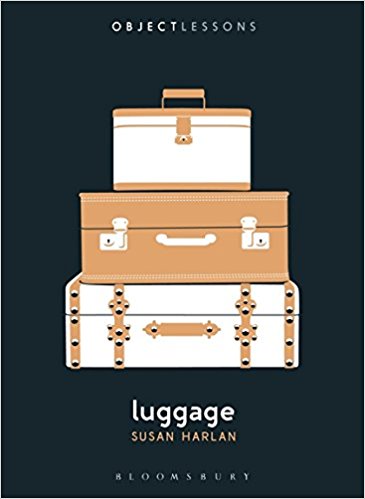 After a long day of air travel from North Carolina to Sacramento, I arrived at the baggage carousel to collect my big, black suitcase. I’d packed for the summer and my life for the next two months was all there: eye wear, books, clothes, toiletries. As I watched the carousel go round and round without my suitcase, I recalled the adage about there being only two types of luggage: carry-on and lost. Passenger after passenger from my flight reclaimed baggage and still I waited. The area emptied. Only two bags remained and neither was mine. Indignant, I marched to the lost luggage office to complain. Before filling out the forms, though, the claim attendant insisted on returning to the luggage carousel to have another look. Only one suitcase remained—a big, black, and nondescript behemoth. “That’s not mine,” I insisted, but the attendant lifted it off the carousel and plucked the tag out from under the handle to show me…my own name. “Happens all the time,” the man said, which I thought gracious. I had forgotten all about my idiocy, but thanks to Susan Harlan’s new book, Luggage, that moment has been vividly brought back to mind.
After a long day of air travel from North Carolina to Sacramento, I arrived at the baggage carousel to collect my big, black suitcase. I’d packed for the summer and my life for the next two months was all there: eye wear, books, clothes, toiletries. As I watched the carousel go round and round without my suitcase, I recalled the adage about there being only two types of luggage: carry-on and lost. Passenger after passenger from my flight reclaimed baggage and still I waited. The area emptied. Only two bags remained and neither was mine. Indignant, I marched to the lost luggage office to complain. Before filling out the forms, though, the claim attendant insisted on returning to the luggage carousel to have another look. Only one suitcase remained—a big, black, and nondescript behemoth. “That’s not mine,” I insisted, but the attendant lifted it off the carousel and plucked the tag out from under the handle to show me…my own name. “Happens all the time,” the man said, which I thought gracious. I had forgotten all about my idiocy, but thanks to Susan Harlan’s new book, Luggage, that moment has been vividly brought back to mind.
From Herodotus to pilgrims of the Middle Ages to the 21st century traveler to the real and the fictional, Harlan explores the accouterment of journeys in this latest installment of the Bloomsbury “Object Lessons” series—books that take on “the hidden lives of ordinary things.” Harlan’s academic work on ordnance in Shakespeare and her professed love of objects inform this little book. An intimate look at suitcases, trunks, totes, and other baggage, Luggage illuminates the intricacies of how we carry our lives with us when we travel.
Full of factoids and observations, Harlan lurches from the mundane to the fascinating. A visit to the Unclaimed Baggage Center in Alabama is both. The Center, one of Alabama’s “top tourist attractions,” is where the country’s unclaimed luggage is sorted and sold or displayed. While it was fascinating to learn about this place, I didn’t need to know that Harlan had to stop to look up directions. However, I appreciated the notion that without our luggage, “we’re set loose in the world unprepared…[t]his is the anxiety at the heart of lost luggage.” Harlan also, to varying degrees of effectiveness, unpacks the etymology of the word “luggage” and outlines the growth of tourism. But Harlan is at her best when she explores the luggage of film and literature. There is Mary Poppins and her “infinite” carpet bag. The suitcase of Orhan Pamuk’s father is luggage which “tells a story about exile.” There are the soldiers in Tim O’Brien’s “The Things They Carried” and those pieces of home they brought with them to Vietnam. And I was delighted to find that Grace Kelly’s perfect little overnight case in Rear Window got a mention.
Harlan’s exploration of the minutiae of luggage makes for introspection. While reading, I found myself thinking of baggage and travel I’d not contemplated in some time, and in some cases, not at all. I was embarrassed all over again when Harlan discusses nondescript black suitcases, and was happy to have confirmed my own impression of the Sacramento airport’s Auschwitz-like display of suitcases. I recalled a trip to the lost luggage counter in Frankfurt when most of my baggage went missing at customs and my outsized joy when they were delivered to me in Prague just a few days later. There were the green Atlantic suitcases I received for my high school graduation that I took to Mexico, and the big backpack I carried to Guatemala. After weeks of being on the road and sleeping in bunkhouses with other people, that backpack became a repository of space that was just my own. During travel, as Harlan says, “[a] suitcase marks the boundary between inside and outside; public and private.”
Harlan mines the life of things we pay little attention to, or simply don’t recall, and calls up nostalgia through the memory of objects. The Samsonite line of marbled tan suitcases Harlan describes were a fixture of my childhood—in particular, the overnight case, with its mirror and faux-silk lining and pockets. When I wasn’t using it for sleepovers, I used that case as a vanity and repository for secret, special items, like folded notes and seashells. In Luggage, Harlan brings it all back with a rush of delight—just like a lost suitcase, returned at last.
___
Adrienne Pilon is a traveler, teacher and writer. She lives in North Carolina with her family.

1 comment
M Moynihan says:
May 23, 2018
Wonderful article – reading it brought back mental pictures of the various bags, backpacks, totes, & large purses that have traveled with me – just ordered the book